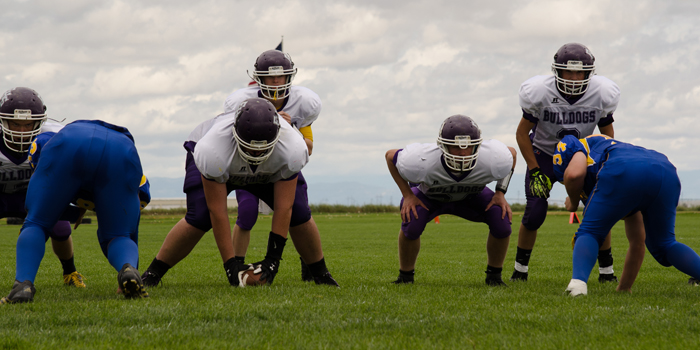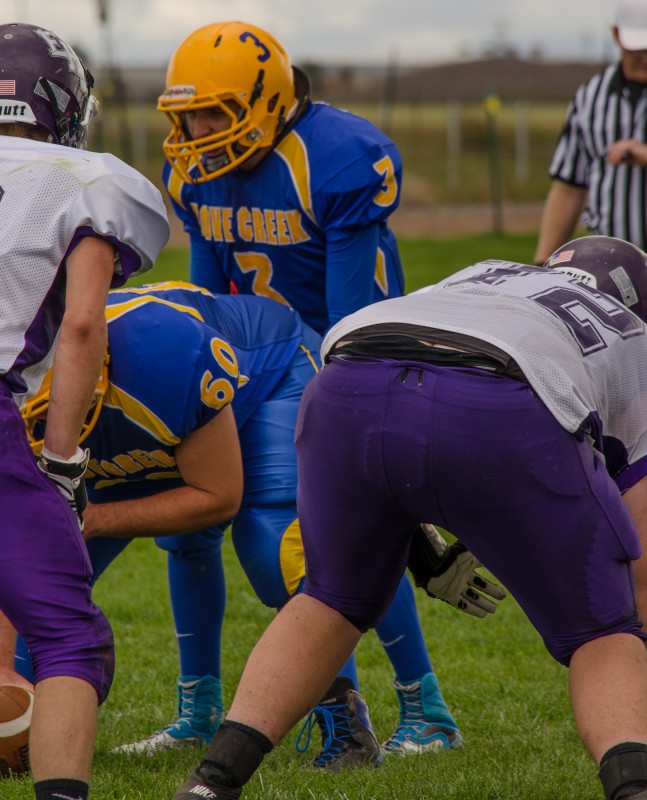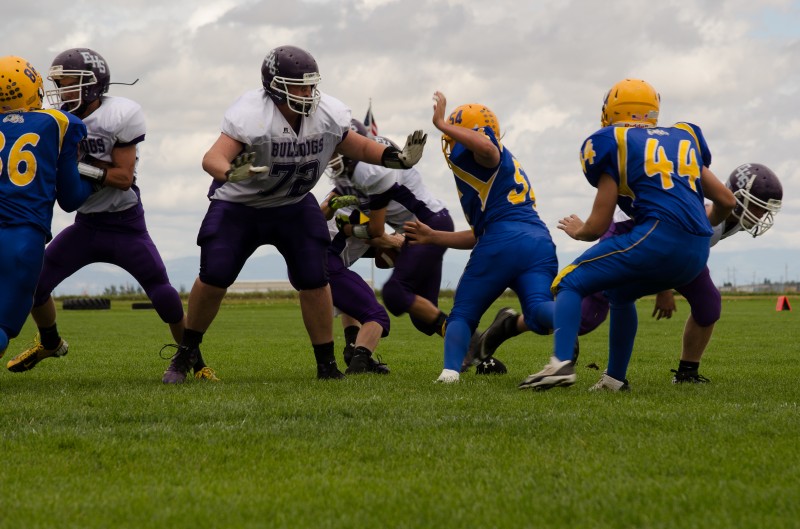
In coaching and how I run my clinic, I believe my job is not to just simply provide a service during practice. What I mean by this is if by the end of the practice, all I’ve done is set up and monitor some drills, I have failed as a coach. My real job as a coach is to pass on the knowledge and experiences I have gained in my years playing football.
This develops athletes who will better understand their sport and provides the tools necessary for them to self-regulate and self-critique their performance. The quicker the athlete can develop these skills, the more successful they will become. In short, I believe the primary roles of my job as a coach are to:
- Build the competence of my offensive linemen to a level in which they can analyze, coach, and execute with each other or by themselves.
- Pass on the lessons and habits for success that I wish someone had taught me when I was younger.
The offensive line is an immensely complicated position. Whereas you will often see a true freshman playing wide receiver, cornerback, or running back, it is rare to see a first-year player start at the offensive line position (so long as the team itself is not completely worthless).
This is because it is very difficult to be developed enough to be successful in the offensive line position. So how does a young offensive lineman better prepare themselves to be successful at the high school level and make themselves highly attractive to teams at the highest level of competition?
What I have learned over the last decade of experience working within collegiate athletics is that the answer is very simple but not easy. In short, success for an offensive line comes down to three attributes: Smart. Detailed. Tough. Here are three lessons I pass on to my athletes to build the foundation for achieving these three attributes.

1. Detail Everything
Most people have watched a highly skilled person perform multiple tasks at once and wondered, How in the hell can he make that look so effortless? The answer, of course, is that person has spent so much time practicing and refining these tasks that they can practically (and sometimes, literally) do them blindfolded.
To an offensive lineman, these motor skills are run and pass blocking techniques. Excellent technique requires detailing and execution of every step involved with a block. Most of the time, mental mistakes, problems with focus and execution (a snap count, scheme, or block), and inconsistent performance are simply due to problems in technique.
An offensive lineman must place time and emphasis on the detailing and building better technique. The offensive line is not a talent-based position in that it is not a position that an athlete can naturally be successful at and execute with sub-par form. Blocking is dependent on leverages and positioning (technique).
Now, before the Internet warriors jump all over this to point out that there are no successful 5-foot-9, 250-pound offensive linemen with a 5-rep 225-pound bench playing at in Division I athletics or in the NFL, this doesn’t mean that physical attributes of athleticism and strength are completely irrelevant. These factors are relevant to the point that a baseline is met (i.e., having a 575- versus 600- versus 650-pound squat has little to no measure of success on an offensive lineman. If a 550-pound squatter can obtain and maintain horizontal (inside) and vertical leverage, he will drive a 650-pound squatter off the ball every play.
Detailing requires you to analyze critically. In football, this requires you to break down technique in every drill and every repetition. This is best done by watching film. Now, almost everyone watches film. Even in the strength industry, many people film their lifts and then watch that film. The question is this: How is that film broken down and analyzed in detail? Most offensive linemen watch film and simply look to see if they blocked their man or not and then move on to the next play. This kind of detail will take about 20 minutes to watch an entire game worth of offensive plays.
Properly detailing and analyzing yourself requires breaking down each and every step of the block from the first and second steps, pad level, aiming point, hand positioning, head positioning, leg drive, effort, and then finally, how they finish the block.
RELATED: 8-Weeks-Til-Camp Summer Program for High School Football
Clichés exist for a reason, and there’s a reason why football is called a game of inches. Becoming good at focusing on the little details allow the athlete to hone in on a technique and put themselves in the best position for success. It also allows the athlete to then develop and engrain proper motor patterns and move on to more complex tasks, such as reading defenses, reacting to a defender, and performing under high-stress scenarios while maintaining form.
Focusing in on the details sets the foundation for everything else that occurs on the field. Once an athlete learns how to detail their technique, the next challenge becomes perfecting it.
2. Chase Perfection
Lesson 1: Detailing everything highlights the fact that football, in fact, is a game in which every little bit matters. If an inch can win or lose you a game, and this is common enough knowledge that opposing teams, players, etc., are fighting for that inch, the logical follow-up question would be, “How do I get that extra inch?”
Paying attention to details is hugely critical, and what I’ve learned from living the experiences of college athletics in the meeting rooms, on the field, and observing differences between successful and unsuccessful players is that detailing everything is a single step in an overall broader approach to the game.
If you pan out to look at the broad picture, each step to better improve yourself and focus on the details are the building blocks of the end goal for any successful football picture: Perfection. Perfection of technique, perfection of the individual, perfection of the team, and perfect execution of every play that each individual and team plays.
When we break down game film, each player is responsible for grading themselves with either a plus or a minus. Did you do your job? Yes or no? This is the player executing Lesson 1: to be critical and detailed. After every play has been broken down, we then add up all the pluses and minuses to give an overall grade. For example, if out of 100 offensive plays, if you had 80 pluses and 20 minuses you would have scored 80/100, or 80 percent. You would then give yourself a grade. Typically speaking, a good game would grade from 78-85 percent (C+ to B). Grading 85-90 percent (B+ to A-) percent would be exceptional. Ninety percent and above is mastery.
For simplicity’s sake, 100 percent perfect is impossible – and that’s a good thing. It’s a good thing because what you learn is that the closer to that 100 percent you are, the more successful you will be. It also teaches the lesson that there is always room for improvement. If you look at perfection being impossible as a bad thing, you are likely not a great athlete, business owner, parent, spouse, etc. To the true competitor, this lesson is one of the best lessons you can learn because it teaches you that there is never a ceiling or limitations to what you can become.
The lesson is to chase perfection because perfection itself is essentially unobtainable; it is something you are always striving for. So, how do we chase perfection? Start by perfecting the minor details! For the offensive line, we start with our stance and first two steps, as they are the starting point in any block. From there, we move to our aiming point and pad fit, then leg drive, and so on with the goal of putting together a perfect repetition/play.
LISTEN: Table Talk Podcast Clip — JM Blakley and Dave Tate Discuss Meditation for Athletes
Initially, it is very difficult just to get out of a stance with a great first and second step, while managing all the other demands of a block, but as we zero in on technique, we begin to commit these actions to muscle memory. As you get better and better, this allows you to have more success on each play, increasing your consistency and leading you towards the next goal — the perfect drive.
Once you are able to accomplish the perfect rep or play, the focus can then move to a perfect drive, then to a perfect quarter, and then to a perfect game. Now, a perfect game is theoretically impossible, but what it teaches you is that the team that makes the least amount of mistakes and is closest to perfect is often going to be the team that comes out with the win.
The takeaway is this: Details and technique are what allow an offensive lineman to be in the position to be successful on any given play. On any given play, there will likely be things that are done right and done wrong. The closer we can be to 100 percent correct, the more successful we will be. Tracking what you did right and wrong is incredibly important, and if you are able to understand that perfection is the end goal, you will be able to always find something to improve upon to bring you closer to perfection.

3. Never Be Average
Simply put, if you have high expectations for yourself, by definition, you cannot be average. Every high school football player wants to play in college. Every college player wants to play in the NFL. The reality is that most will not. The reason why is up to debate, but I have my doubts that talent has much to do with it. I can’t tell you in the last decade how many talented people I’ve watched throw their college career over some stupid shit.
To me, the recipe for success is very simple: look around and find out what the average person is doing — then make damn sure you are doing more than that. This is the most important lesson I try to hammer into a young aspiring athlete because this is the lesson that I had to learn the hard way. It’s also a lesson that everyone can learn and apply to their life, whether they are a football player, coach, business owner, parent, spouse, or employee.
Being average is very easy. It’s simple math. Simple statistics tell us this. The average person is a C student in school. The average person works 40 hours per week. Most people simply do only what’s required and do not put in the effort necessary to succeed. The average football player goes to practice and workouts and then goes home. Similar to the theme of the book 7 Habits of Highly Effective People, there are simply things that highly successful football players do that others do not do.
I’ve seen a first-year starter who was destined for the NFL quit because he was homesick. Every season, a guy was kicked off the team or lost their spot because they couldn’t keep away from alcohol or drugs, show up to class or tutor appointments, or just simply put in effort at practice and workouts. There are many reasons why an individual leaves the team or doesn’t become a starter.
READ MORE: The Lost Art of Training Hard
For me, it was not recognizing the importance of taking initiative to execute and improve myself outside of the time required. I didn’t spend extra time in the building when no one else did. I didn’t spend more time working on my weaknesses, my diet, and putting in extra hours outside of mandatory meetings, workouts, and practice.
Now, I’m not saying there isn’t anything wrong with being average. And I’ll never tell a young athlete that they can’t play in college or the NFL. My job as a coach is to make sure that they realize what kind of effort, dedication, and attitude will be required to accomplish the expectations they have for themselves.
All the examples I gave of players who didn’t have what it took to get to the next level were examples of allowing yourself to become average. There’s nothing wrong with wanting to see your family. Most college kids drink alcohol and stay out late. Plenty of people flunk out of school and have subpar grades. Too many people spend all their free time on activities like video games, TV, or the Internet instead of reinvesting in their personal improvement. But that’s what the average person doe
For many athletes, I believe it is a case of unconscious incompetence. They simply don’t know what’s required of them in order to be successful or where they should be improving. If an athlete understands what is required of them and decides that it is not something they want to pursue, that is absolutely fine with me.
But as a coach, being able to clearly articulate to an athlete the attitude of never being average is the most important lesson I can teach. One of the ways I articulate this is by simply telling them to get used to doing things that no one else is doing. In fact, make it a goal to ensure that whatever everyone else is doing, you’re either doing it better or more. This is a simple guide to developing the mindset of never being average.
These lessons may seem like a lot to be teaching a high school athlete, but these are lessons that can be applied regardless of the level of mastery an athlete has obtained. The point is to understand them and apply these lessons as soon as possible in one’s career so they can be there to guide the athlete as they grow in the sport. Furthermore, no one said success is easy — certainly not for someone who is trying to accomplish a feat such as playing in college or the NFL.
Living, learning, and passing on are not about making processes like these easy. Just as there will never be a perfect performance, there is no such thing as an easy route to success. It is about making the path for the next person a little clearer and a little more navigable.
Some mistakes and lessons have to be learned on their own. In fact, I would be willing to argue that by easing or accelerating the process of becoming a Division I athlete in one way, I will probably put some of my athletes in a position to encounter new experiences and new mistakes that I haven’t dealt with. Eventually, if I’ve done my job correctly, these individuals should be able to teach me something. That is how you progress in a sport, a business, or a way of life.
Images courtesy of Elane Graves © 123rf.com











1 Comment